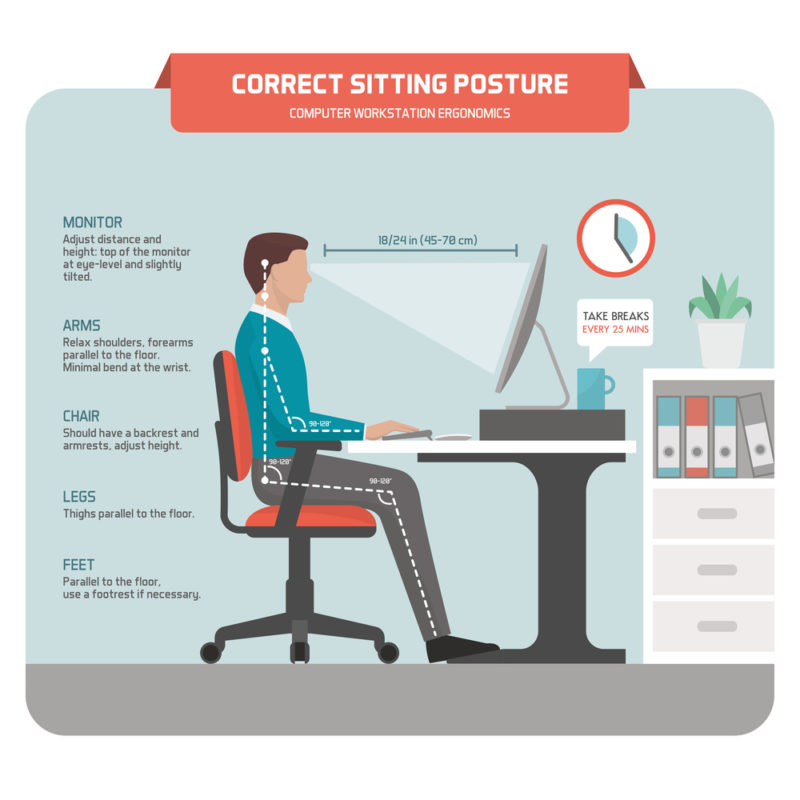Work From Home Tips & Tricks in 2025: First-Steps & Productivity Guide
Transitioning to a work from home life can be difficult. So we’ve compiled this list of handy work from home tips to help you make the most of this new way of living, both in terms of making sure you’re productive and safeguarding your mental well-being and home life.
For fairly obvious reasons, remote work has exploded since early 2020. Although this was already an ongoing trend, the emergence of COVID-19 kicked it into overdrive, with more people than ever before doing their work from their homes. Here, we’ve collected some handy work from home tips and tricks to help you get started and stay productive while working from home.
Key Takeaways:
- Working from home has exploded since the start of 2020, and there are tons of different remote jobs.
- Maintaining productivity and a healthy work-life balance are among the biggest challenges for remote workers.
- Managing remote employees comes with a whole set of new challenges for managers and business owners.
Here at Cloudwards, we have tons of experience working remotely — whether that’s from the comfort of home or a cozy coffee shop down the road. Because of this, we have some insight into how to make this kind of work style a little easier, both in terms of staying on top of your tasks and safeguarding your personal and mental well-being.
We’ve also included some tips for employers who may be considering sending employees home or keeping them in the office. So without further ado, let’s dig into some tips for remote employees and employers alike.
-
07/11/2021
Restructured article to provide remote work tips.
Work From Home Tips and Tricks: How to Work From Home
The first step to working from home is to actually find work that you can do remotely. For many, this step happened automatically, as numerous businesses shifted from having workers come into the office to performing their labor from the comfort of their own homes.
Avoid Costly Project Management Mistakes – Get Free Tips Today!

- Discover 10 fundamentals of project management
- Understand step-by-step plans for PM execution
- Learn tips to avoid 5 common mistakes by beginners
If your company isn’t among one of these, though — or if it’s starting to call its workers back to the office as the pandemic winds down — you might be wondering what kind of work you can do remotely and where to find it.
What Kind of Work Can Be Done Remotely
It might surprise you to learn that you can do all sorts of work remotely. Unfortunately, we can’t tell you what work you’ll want to do, as this will largely depend on your skills and interests. Common fields include online marketing, search engine optimization, graphic design, writing, teaching, software engineering, photography and video editing.
How to Find Remote Work
There are countless remote work job boards out there, and where you want to look will largely depend on what kind of work you want to do and whether or not you want a permanent position or freelance gigs.
Probably the most popular remote work website is upwork.com. There you can find all sorts of work, including teaching, software engineering, writing, online marketing and anything in between. One downside is that Upwork is somewhat more selective than other job boards, and you need to put some work into creating your profile before it’ll accept you.
Another downside of Upwork is that once you earn more than $500 through the site, it’ll start taking a cut of your future gigs. That said, many people use the site merely as a way to connect with employers and continue the relationship outside of the platform, circumventing its commission.
Besides Upwork, there are other general remote work job boards — such as hubstaff.com and fiverr.com — which have the benefit of being a bit easier to get started with the platforms. Writers can also use job boards like problogger.com and bloggingpro.com, where you might even see a Cloudwards ad from time to time.
These are just some of the most popular sites, though, and we could spend all day listing various websites you could visit to find work, depending on your field.
Some more examples are remoteok.io, remote.co, workingnomads.co, remotecircle.com (which organizes listings by time zone) and skipthedrive.com. There are many more, so we recommend some Googling to find the job board that suits you best if none of these have what you want.
21 Working From Home Tips
Once you’ve found some remote work — whether by looking for it yourself or by already working for a business that went remote — you might want to know some work from home best practices for how to go about actually doing it. The two biggest challenges with working from home are probably productivity and work-life balance, so those are the areas we’ve focused on for this list.

Productivity Tips for Working Remotely
One of the biggest challenges for remote workers is productivity. Although many find that it’s actually easier to be productive without co-workers stopping by for a chat every 15 minutes, and despite numerous benefits of working remotely, working from home also comes with a bunch of new challenges and distractions that this work from home advice will hopefully help you alleviate.
1. Create a Morning Routine
Without the morning commute into the office, it can be difficult to maintain a routine for getting out of bed and getting started with the day. If you follow the same routine every morning — whether that’s a good cup of coffee, a workout or a healthy snack — then it’ll be much easier to make sure you get into a productive frame of mind once you start working in the morning hours.
2. Set a Stable Schedule
Similar to the last tip, staying productive is much easier when you have a set work schedule that doesn’t wildly alternate day by day. Create set “office hours” for yourself and make sure that you don’t let other concerns distract you during these times. On the flip side, you should avoid letting your work bleed into your “off time” as well.
3. Get the Right Equipment
One of the downsides of not being in an office is that you might not have access to all the right equipment to ensure efficiency and productivity. A computer is obvious, but other items such as an extra monitor, a high-performance router, a comfortable chair, an ergonomic desk setup and any other home office equipment specifically related to your field can also help. The right equipment can make your work go from feeling like you’re pulling teeth to flowing smoothly.
4. Ergonomics & Body Posture
Sitting hunched over a coffee table will wreak havoc on your back in the long term. In fact, even sitting on a regular chair at a desk isn’t ideal, which can lead to long-term health issues, such as chronic neck pain or carpal tunnel syndrome. So if you have a dedicated space to do your work, investing in an ergonomic chair and perhaps even a standing desk can save you a lot of pain down the road.

5. Track Your Time
It’s very easy to get distracted if you’re working from home or a workspace. The most important step to avoid this is to be aware of how you’re spending your time. Knowledge is power, and there are tons of different time-tracking software like Timewarp that you can use to give you more insight into how much you’re actually working and time spent on specific tasks on any given day.
6. Work From Home Productivity Software
There are a lot of quality technology solutions out there to help you increase your productivity. These can take the form of project management software like Trello or Asana that lets you set up a task list or activity tracking, software that blocks out distracting social media notifications like StayFocusd or a solid note-taking tool like Evernote (read our Evernote review).
7. Stay Organized While You Work From Home
When working from home, it’s on you to make sure you keep your work organized. There are tons of tools to help you with this, from creating a to-do list with an app like Todoist (read our Todoist review) to setting up automations in Google Calendar with apps like IFTTT and Zapier.

track as unfinished tasks start piling up.
8. Create a Comfortable Home Office
Working from the couch or your bed is not a great way to stay productive. If you have the space, you should create a dedicated area for work, preferably in a well-lit room that has plenty of natural light, where you can isolate yourself from family members to get enough peace and quiet to actually get some work done.
9. … Or Find a Workspace That Suits You
If there’s no suitable space in your actual home to do work from, you’ll need to find an alternative. The most obvious choice is a good workspace or coworking space if there’s one in your vicinity, but places like coffee shops and libraries with good natural lighting also make excellent alternatives. Another option to consider is setting up a virtual office, which provides services like a business address for LLC registration, meeting‑room access, etc.
10. Eliminate Background Noise As You Work From Home
If you spend a lot of time on conference calls or video meetings throughout the day, then eliminating background noise is crucial. This can be difficult if you’re working in a public or unconventional space, though. So consider the noise level of any spot you’re thinking about as your remote working location.
Personal Life Tips for Remote Workers
When working from home, it can be hard to separate your personal life from your professional life. Not only can this harm your productivity, but it can also seriously impact your mental health and work-life balance. Here are some tips we’ve found helpful for alleviating any issues that may arise from having your work and personal life in the same space.
11. Get Enough Sleep
Without the natural boundary of the office separating work from personal life, it can be easy to let everything you need to get done impact your sleep schedule. Because of this, it’s important to exercise self-control and get all the sound sleep you need. Sleep deprivation and the lack of a proper sleep schedule is a surefire way to hurt your mental and physical health, as well as your job performance.
12. Create Firm Boundaries With Family Members
It can be easy for family members to assume that since you’re at home, you’re always available to them. It’s crucial to set ground rules for your family members and make it clear that just because you’re on your laptop at home, it doesn’t mean you’re free to do whatever.

stop family members from interrupting your work.
13. Set Limits for When You Work
A strict routine doesn’t just help you get stuff done for your job. It also sets boundaries that make sure your work doesn’t invade your personal or family time. If work is constantly on your mind all day long, you risk burning out or not performing well when you’re actually supposed to work.
14. Take Breaks When You Need Them
Without casual social interactions and small talk with co-workers, it can be easy to forget to take the breaks that you need. Whether this is a quick five-minute rest, a proper lunch break or a long walk, you may find that taking a breather and stepping away from a problem makes it much easier to focus and solve once you get back to it.

15. Make Sure to Get Fresh Air
In the same vein, try to use a few breaks throughout the day to get some fresh air. Sitting cooped up in the same indoor space for all of your work hours is not good for anyone. So make sure you get out of the house (or coffee shop) and walk around for a few minutes.
Tips for Remote Employers
If you’re an employer, manager or business owner, you might also be wondering how to structure your business the most efficiently for remote work. Here are some tips on how you can go about having your employees work from home (or remotely) without seeing your results or workplace culture impacted.
16. Emphasize Communication
The core component of any remote workplace is communication. If a company communicates well, both in terms of expectations and feedback, then chances are your employees will meet the goals you set for them — or at the very least, feel comfortable telling you when something isn’t going as planned.
17. Schedule Video Calls
A good way to make sure that your employees are making progress on the tasks assigned to them is to schedule regular video calls. This can be daily, weekly or bi-weekly, depending on the needs of your company. Regular check-ins let you get direct reports on an employee’s progress without them feeling like you’re breathing down their neck.
18. Be Flexible When Possible
Although sometimes it’s important that certain employees work on the same schedule, you should try to be as flexible as possible with work hours. One of the big reasons people like working from home is that they’re not necessarily tied to the standard nine-to-five schedule. So, this is something you should try to accommodate wherever possible.
19. Organize Remote Team-Building Events
One of the biggest concerns for managers and employers when shifting employees to working from home is maintaining a healthy company culture. A good way to do this is to schedule a regular video chat with everyone at the company (or department) that isn’t focused on work but rather on getting to know one another and making sure they feel connected.
20. Trust Your Employees as They Work From Home
Although it might be tempting to install all sorts of Orwellian software on your employees’ devices to make sure they’re working as many hours as you want them to, this is probably not a good idea. Instead of focusing on how many working hours they get done, prioritize actual results. After all, if a remote employee does what you need them to do, does it really matter how long it took them?

21. Figure Out How Much Interaction Is Needed
Every company and person is different. Some employees might benefit from a daily check-in, while others will perform much better with a looser hand. You should evaluate each role and person at your company to figure out exactly how much interaction is needed for them to stay productive and perform at their highest level.
Final Thoughts: How to Start Working From Home
There you have it: our list of work from home tips. Although some of these might seem obvious for working remotely, they can be easy to forget and are useful things to keep in mind whether you’re working a full-time job from home, freelancing or employing people who aren’t physically present in the office.
If you like visiting new places, you can also read our tips on how to travel and work remotely, as well as the latest remote work statistics.
What did you think of our tips? Did we provide you with any new revelations or was it full of things you already knew? Are you struggling to stay on the same page as your co-workers when you’re not physically present in the same building or is the mere act of working from wherever you please doing wonders for your productivity? Let us know in the comments below. Thank you for reading.
FAQ
There are many things you shouldn’t do while working from home. Some examples are letting personal distractions get in the way of your work, forgetting to take breaks (or off time) and working in an unproductive space.
There are countless fields suited to working from home. These include IT work, writing, teaching, marketing and many more.
The first step is to actually find a remote job that suits your interests and skill set. The easiest and safest way might be to approach your current employer about moving your workplace to your home. You can also hit up a variety of remote work job boards to find location-independent full-time positions or freelancing gigs.

